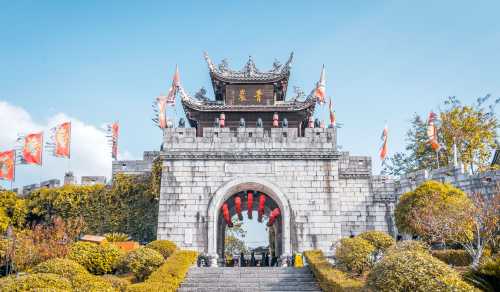App
Customer Support
Find Bookings
Popular Trip Moments
Qingyan Ancient Town: A Stone Epic in the Heart of Guizhou | Discover a Free Charity Art Exhibition at Zhonghao Hotel with a Heartwarming Trial Stay Experience | A Must-Stay in Guiyang - The Best Hotel I've Ever Experienced: Zhenbo Hotel Guiyang is Amazing | Guiyang Denggao Yunshan | A Hidden Gem Park Adventure | Business travelers staying here make every minute count | My boyfriend took me on a trip and we stayed at this hidden gem hotel—absolutely loved it! | Encounter a Hidden Paradise! This Guesthouse Offers Poetry and Tranquility | Huangguoshu Waterfall Latest Queue-Skipping Guide: Save Time and Effort to Explore the Highlights! | Waterfalls cascade from the heavens, emerald waters carve through sheer cliffs! | Van House·Zhuangyuan Garden | The heart of Guiyang! Sleep well, eat deliciously, and even your furry friends will praise it! | Starting from Huacheng Wooden Lodge, Encounter the Beauty of Qingzhen | 5-Day 4-Night Guizhou Relaxing Tour for Seniors! No Hiking Version | 6-Day 5-Night Guizhou Photography Tour! Maximize Your Shot Success Rate! | Jiaxiu Tower: Guiyang's Four-Century Cultural Landmark | 5-Day Guizhou Light Hiking | 15-Person Group Landscape & Folk Culture Experience | 6-Day Guizhou Honeymoon Mirror | A Slow Journey for Two Witnessed by Mountains and Waters | 5-Hour In-Depth Tour of Guiyang City Center | Includes Foodie Map | 5 Days Deep Tour in Guizhou, Guaranteed Group Formation~ | Guiyang! A Hotel You'll Fall in Love with at First Stay | Guiyang! A Hotel You'll Fall in Love with at First Stay | 5 Days 4 Nights Huangguoshu In-Depth Tour|Peak Water Season | 4-Day Fanjing Mountain Stress Relief Trip|Mountain and Water Healing | My favorite travel cities of the year are here! | Qianling Mountain Park, a green oasis in the bustling city | This is the ultimate way to enjoy a trip to Guiyang! | Zijiang Rift: Venture into a 20°C Prehistoric Glacier! | "Hidden Gems Around Guiyang: Waterfalls, Caves, and Miao Villages Unknown to 99% of Tourists!" | Discover Qingyan Ancient Town: Unlocking Guiyang's Millennium Cultural Treasure! | Stay at the Sofitel Guiyang Hunter and enjoy the prime views of Guiyang
Recommended Attractions at Popular Destinations
Attraction near Bangkok | Attraction near Manila | Attraction near Tokyo | Attraction near Taipei | Attraction near Hong Kong | Attraction near Seoul | Attraction near Kuala Lumpur | Attraction near Los Angeles | Attraction near Shanghai | Attraction near New York | Attraction near Shenzhen | Attraction near Osaka | Attraction near Singapore | Attraction near London | Attraction near Guangzhou | Attraction near San Francisco | Attraction near Beijing | Attraction near Macau | Attraction near Bali | Attraction near Jakarta | Attraction near Paris | Attraction near Ho Chi Minh City | Attraction near Istanbul | Attraction near Phuket | Attraction near Chicago | Attraction near Seattle | Attraction near Toronto | Attraction near Orlando | Attraction near Cebu | Attraction near Chiang Mai
Popular Restaurants in Guiyang
NAN MEN KOU | 南一酒馆私房菜 | LAO KAI LI | SHU CHU | Xin Da Xin Dou Mi Hotpot | QI SHI TASTE OF HOME | Xiejia Centennium Gaoba | Silianhongtangsiwawa (hongtongcheng) | Siliansiwawa (huaguoyuandian) | QIN YU WENG | 茉莉餐厅Morning Flowers | MAOLAGO | QIAN DA SHU DA PAI DANG | 亮欢寨快活林酸汤鱼酸汤牛肉火锅店(甲秀楼店) | XiaoYa Homestyle Restaurant | Guailu Style | 煮意潮牛鲜牛肉火锅(甲秀楼店) | 丝恋丝娃娃(南国花锦店) | 陌坂日式焼肉(小十字店) | Nectar one | 贵阳亨特索菲特酒店·乐吧 | 银鹤料理(太平路店) | Hu'ayishanjidoufu (mengxiangchengzongdian) | 贵阳亨特索菲特酒店·乐轩华·粤菜海鲜食府 | 贵阳万丽酒店新满福楼餐厅 | Aduchaoxie·longxia,shaokao,haixian(yunyandian) | 海底捞火锅(云上方舟店) | 觅渔泰式海鲜火锅(喷水池店) | 57° Teppanyaki (huaguoyuan) | 不站·花胶鸡(世纪金源店)
Popular Ranked Lists
Popular Must-Visit Restaurants in Taipei | Top 8 Local Restaurants in Langzhong | Popular Luxury Hotels in Nizwa | Top 9 Local Restaurants in Lushan Global Geopark | Popular Luxury Hotels in Astana | Popular Best Things to Do in Shangqiu | Popular Must-Visit Restaurants in Songyang | Popular Must-Visit Restaurants in Osaka | Popular Must-Visit Restaurants in Milan | Popular Best Things to Do in Xinchang | Top 4 Best Things to Do in Guigang | Popular Must-Visit Restaurants in Seoul | Popular Luxury Hotels in Oslo County | Popular Luxury Hotels in Koyaki | Top 9 Best Things to Do in Hechi | Popular Local Restaurants in Bangkok | Popular Luxury Hotels Near Tatsugo | Popular Best Things to Do in Baiyin | Top 4 Best Things to Do in Yingkou | Popular Best Things to Do in Huangshi | Popular Luxury Hotels Near Owani | Top 15 Best Things to Do in Ganzi Prefecture | Popular Must-Visit Restaurants in Athens | Top 4 Best Things to Do in Dongfang | Popular Must-Visit Restaurants in Dalat | Popular Best Things to Do in Luanping | Top 6 Best Things to Do in Jincheng | Top 3 Best Things to Do in Shengsi | Popular Luxury Hotels Near Lazaro Cardenas Municipality | Popular Luxury Hotels in Kathmandu
Payment Methods
Our Partners
Copyright © 2025 Trip.com Travel Singapore Pte. Ltd. All rights reserved
Site Operator: Trip.com Travel Singapore Pte. Ltd.
Site Operator: Trip.com Travel Singapore Pte. Ltd.































